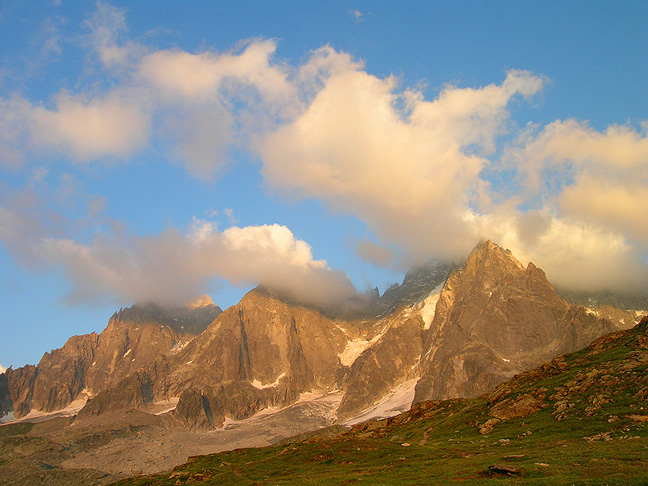
 |
|
| Aiguille du Peigne |
| Difficulty Schedule Maximum
Ratio Combine
with: |
In French "Peigne" means cockscomb, and this is a good word to describe the sharp, spiky fin of the summit ridge of this wonderful peak. The Chamonix Aiguilles have many great climbs, but the excellent rock, easy access from the Plan des Aiguilles, and the fine climbing make the Peigne perhaps the most visited of all of them. This is a rock climber's peak. All the routes to the top are technical and all fairly long. Most of the routes can be accessed with only minimal travel on snow, so ice ax and crampons can be left in the hotel room. Also, the Aiguille du Peigne is at a somewhat lower altitude–when the high peaks are out of condition in new snow, often the Peigne is still climbable. There are literally dozens of routes on this peak. The great rock and quick access have encouraged climbers to venture everywhere on its walls. Most of the routes climb only the lower stretches of the mountain, and top out either on the major ledge system at the top of the NW Face, or at the crest of whatever buttress they ascend. These are great climbs and justifiably popular. But to truly enjoy this peak in the fullest alpine sense, you need to climb to the summit. The pitches on the summit tower are classic alpine rock climbing, great rock, intricate, with outrageous exposure. There are many ways to "approach" the summit tower. On this page we will describe three of them, all of them individual rock climbs, and often climbed in their own right. But all of them can be easily continued to the summit for a full day out. For all of these routes, it makes sense to climb in rock shoes, but carry boots for the easier sections of the peak and for the descent. We usually leave boots and other extra gear at the base of the summit tower, allowing us to do those last steep pitches unburdened. Eperon Minettes is the easiest of our selection of three. (The normal route on the Peigne is easier still, but the quality of climbing is not nearly as good.) On the west face of the peak, just right of the Papillons Couloir and the normal route, is a buttress of clean rock. There are maybe 5 or 6 good pitches here, much of it bolt protected with good anchors and fun climbing. Difficulty is to about 5.6-7. From the top of this climb, an easy scramble brings us to the an intersection with the normal route which we then follow up the summit tower. The Arête des Papillons is a well known route on a very pronounced lower NW ridge of the peak. The climbing among, over and around the many towers of the ridge is varied and complex. There are wide cracks, thin faces and everything in between. One particularly difficult section is usually done with a bit of helpful aid. There are many pitches on the Arête, so climbers on this route need to be speedy if the also plan on going to the summit. Most of the parties on the Papillons usually descend after completing the Arête section, leaving the summit tower for a day when they either have more time and/or energy. Our last route is Lépidoptères, a fine route that intersects the top of the Arête des Papillons. This is mainly a slab climb with thin moves and continuously difficult climbing. Though the hardest moves on the Papillons are harder than anything on Lépidoptères, the latter is more continuous. The hardest pitches are about 5.8. |
||||
 |
|
| The Chamonix Aiguilles | |
Difficulty The Peigne is a rock summit, a sharp clean tower set among the more forbidding north faces of the Midi and Plan. All routes are technical and no matter how you slice it, you have to climb rock to about 5.7 to get to the top. Routes are long as well. All of the routes we mentioned are at least 20 pitches in length. These are big days, with an early start. Prerequisites The Peigne is a rock climber's peak. Climbers need to be comfortable on 5.8 rock and be efficient on long routes. On long days, such as these, a high level of fitness is needed. Combinations While the Peigne can be climbed from Chamonix by taking an early lift, there is a comfortable hut, the Plan des Aiguilles hut (remodeled in 2004/5) near the base of the climbs. From a base at the hut there are many very fine routes, including the Frendo Spur on the Aiguille du Midi, as well as classic rock climbs on the Charmoz, Grépon, Blaitière and the Aiguille de l'M. |
||||
 |
|
| Descending above the NW face. | |
 |
Kathy Cosley & Mark Houston AMGA Certified • SNGM members All images, layout and text ©2004 Cosley & Houston Alpine Guides, All Rights Reserved |
|